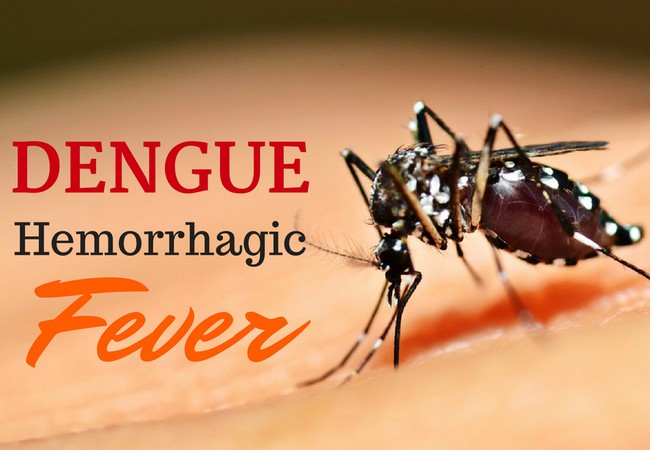Definition of Dengue Haemorrhagic Fever (DHF):
According to WHO, dengue hemorrhagic fever is defined as “a dengue like illness with thrombocytopenia (100 x 10˄9/L) and a hemoconcentration (hematocrit elevated by 20%). It is a much more severe disease than classical dengue fever, with a fatality rate that approaches 10%.

Characteristics of Dengue Haemorrhagic Fever (DHF):
DHF is characterized by –
- Initially the picture is same as classical dengue.
- Then haemorrhage (especially skin and GIT) and shock.
- Thrombocytopenia (platelet count < 1, 00,000 / cu mm of blood).
- Rise of the haematocrit > 20%.
Clinical Features or Sign and Symptoms of Dengue Haemorrhagic Fever:
1. Prodromal (2 days): Malaise, Headache
2. Acute:
- Fever: Acute onset, high, continuous or , saddle back, with break on 4-5th day and lasting 2-8 days,
- Headache, backache, arthralgia,
- Generalized pain-break bone fever,
- Pain on eye movement, lacrimation,
- Anorexia, nausea, vomiting,
- Depression,
- Relative bradycardia,
- Lymphadenopathy,
- Rash transient macular in first 1-2 days,
- Maculopapular, scarlet,
- From 3-5th day on trunk, spreading centrifugally sparing palm and sole,
- May desquamate on resolution,
- Prostration,
- Scleral injection.
3. Convalescence- slow
4. Any of the following hemorrhagic manifestation: Petechiae, purpura, echymosis, pistaxis, gum bleeding and haematemesis.
5. Features of shock– manifested by-
- Sweating on forehead,
- Rapid thread pulse,
- Hypotension,
- Shallow breathing,
- Cold clammy skin,
- Restlessness,
- Oliguria.
Grading Level of Dengue Haemorrhagic Fever (DHF):
Grading severity or level of DHF have mentioned in the below:
1. Grade-I: Fever accompanied by nonspecific constitutional symptoms the only hemorrhagic manifestation is appositive tourniquet test.
2. Grade-II: Above sign plus spontaneous bleeding.
3. Grade-II: Above sign plus circulatory failure.
4. Grade -IV: Profound shock: undetectable BP and pulse (Grade III and Grade IV known as DSS).
Complications of Dengue Hemorrhagic Fever (DHF):
All the complications of DHF have listed in the below:
1. Intracranial bleeding,
2. Encephalopathy,
3. Convulsions,
4. Renal failure,
5. Hepatic failure,
6. Hemolytic uremic syndrome,
7. Iatrogenic problems like-
- Sepsis,
- Pulmonary edema,
- Over-hydration,
- Electrolyte imbalance.
More questions related to this article:
- What is dengue haemorrhagic virus?
- What are the characteristics of dengue haemorrhagic fever?
- Write down the clinical features of dengue?
- Write down the clinical features of dengue fever.
- What are the clinical features of dengue haemorrhagic virus?
- Write down the grading level of dengue haemorrhagic virus.
- What are the complications of dengue hemorrhagic fever?

Maria Khatun Mona is a Founder and Editor of Nursing Exercise Blog. She is a Nursing and Midwifery Expert. Currently she is working as a Registered Nurse at Evercare Hospital, Dhaka, Bangladesh. She has great passion in writing different articles on Nursing and Midwifery. Mail her at “maria.mona023@gmail.com”
